How to fix a toilet leak: determining the cause of the leak and how to fix it
Few people pay attention to properly working plumbing fixtures. They are perceived as an integral part of a comfortable indoor environment.If symptoms of a breakdown appear: strange sounds, operational problems, or, worst of all, leaks, the equipment must be carefully inspected and repaired.
Experienced plumbers know how to fix a leaking toilet. Let's share their professional secrets.
The content of the article:
- How does a toilet work?
- Types of leaks and ways to eliminate them
- Cracking of putty at the junction with the sewer
- Damaged seals in the corrugation
- Crack in sewer pipe
- Crack in the bowl or base of the toilet
- Water leakage due to excessive condensation
- Leak on the cuff under the toilet shelf
- Damage to the drain mechanism and seal
- Leak at the junction of the flush tank and the shelf
- Factory defective toilet
- Conclusions and useful video on the topic
How does a toilet work?
There are many varieties of this plumbing fixture. Meet hanging And floor designs. The first ones are fixed to a special installation hidden in the wall. The second ones are installed on the floor. Regardless of this, each toilet has three main elements.
The largest structural element is bowl. It usually has the shape of a vessel of the same name, which is why it got its name. The open part of the part gradually turns into a siphon. This is the name of a curved channel, which in working condition is filled with water.
Its diameter and bending shape are calculated in such a way as to allow the required amount of waste to pass through without hindrance. A water seal is formed in the siphon, protecting the room from unpleasant odors.
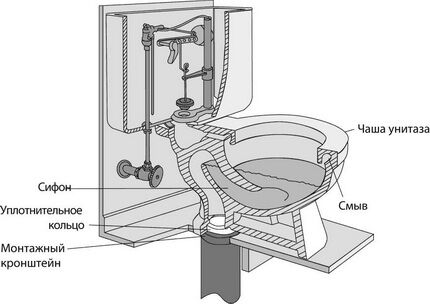
The reservoir in which the water intended for flushing is placed is called cistern. May have a different design and type of liner. It is most often made of ceramic, but can be plastic or metal.
The main elements of the tank can be considered drain fittings, a fill valve, a drain and overflow mechanism. The drain mechanism is activated by pressing a button or lever, this depends on the tank model.
Details designed to ensure maximum comfort when using the toilet are seat and cover. Most often it is made from various plastics; there are models made of wood or soft versions covered with foam rubber. You can also find functional seats. For example, bidet attachments are built into them.
Types of leaks and ways to eliminate them
Water on the bathroom floor is a very unpleasant surprise. Its appearance most often provokes a leak in the toilet.It is possible that this is only the initial symptom of a destructive process, so the first thing to do is turn off the water supply.
Otherwise, there is a risk that the damaged communications will not withstand the fluid pressure and then the consequences of the breakdown will be much worse.
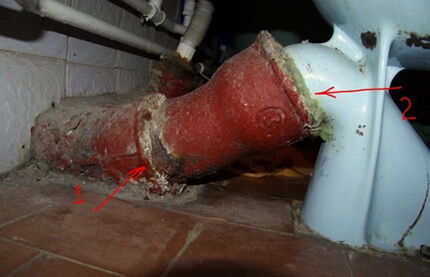
After this, you can begin to search for the leak area and eliminate the problem. The most common causes of leaks include:
Cracking of putty at the junction with the sewer
This can only happen with toilets installed on concrete mortar. Some people prefer this installation method. In this case, the plumbing fixture is placed directly on the solution, and the toilet outlet is also sealed with it.
This is a fairly simple and reliable installation method, but it does not allow for subsequent dismantling of the equipment; its repair is also somewhat more complicated.
A leak in this case occurs due to the fact that over time, the solution that seals the outlet begins to gradually crack. The crumbled remains accumulate under the bell. During the rinsing process, they are flooded and partially carried away by liquid. This is how a leak gradually appears.
To eliminate it, you need to remove the old putty and put in a new one. Some are confident that it will be quite enough to seal the cracked mortar with a new composition.
Practice shows that this is a useless measure, since the leak will resume soon enough. To get rid of it for a long time, take a screwdriver and very carefully remove the remnants of the old solution from the socket.
The procedure is performed carefully and carefully.It is better not to apply excessive force; the bell can easily crack. Then a new joint is made using sealant or cement mortar. In the latter case, it is not recommended to add sand to the composition. This way the connection will last longer.
Repair work in case of cracking of old putty is carried out as follows:
Damaged seals in the corrugation
If the toilet is installed on corrugation, a leak may also appear at the junction of the outlet and the sewer pipe. The reason for its appearance is a dried out seal. The membrane is made of rubber, which over time loses its elasticity and cracks.
This leads to gaps appearing between the toilet outlet and the seal, through which water begins to leak.

To eliminate a leak it is necessary dismantle the toilet. Then remove the used seal and thoroughly clean its seat. Then you should install the new part, placing it on the sealant, and install the toilet in place.
This is the most reliable, but also quite labor-intensive way to eliminate a leak. However, in some cases it is impossible to use it, since the toilet cannot be dismantled.
You can do it differently. Take a screwdriver and use it to turn the old seal to the side. The resulting gap is filled with silicone sealant. If you perform the procedure carefully and carefully, the connection will be reliably sealed and will last for quite a long time.
Crack in sewer pipe
Another very common cause of a leak is a cracked pipe. The most correct solution in this case is to replace the worn part. It happens that for some reason it is impossible to do this right away, but the leak needs to be eliminated.
In this case, you can close the crack with an improvised patch. To do this, you will need a bicycle inner tube, which will act as a repair tool. The rubber bladder is cut and wound around the damaged section of the pipe.
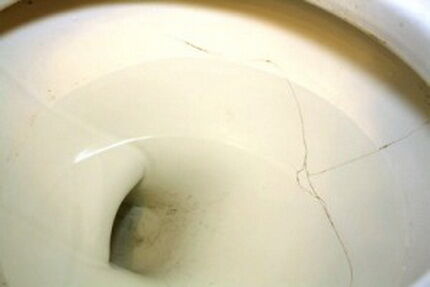
It must be remembered that the winding is done overlapping. That is, each subsequent turn covered the previous one approximately to the middle. The rubber is wound slightly tight so that the connection is sufficiently tight. The last turn is tightened with copper wire.
If you don’t have one, you can take a steel one, but it is susceptible to corrosion and will last less. Leaking connections can be repaired in the same way.The result of the work will be a reliable, but not very aesthetic connection, which will last until the next repair.
Crack in the bowl or base of the toilet
What should you do if the toilet is leaking and the bowl is cracked? This device needs to be replaced. However, if for some reason this cannot be done immediately, the crack should be temporarily sealed.
You need to start by fixing the boundaries of the crack. To do this, through holes are drilled at the ends of the defect. Now the crack will not “creep” further. After this, you should clean it well from the inside.
To ensure high quality cleaning, it is done using an angle grinder. This is a must. Another tool, such as a file, will not help here.
Then, strictly according to the instructions, prepare the epoxy for work and carefully seal the crack with it. Then wait until the composition dries completely. As a result, the plumbing equipment will lose its aesthetic appearance, but will be able to work for some time.
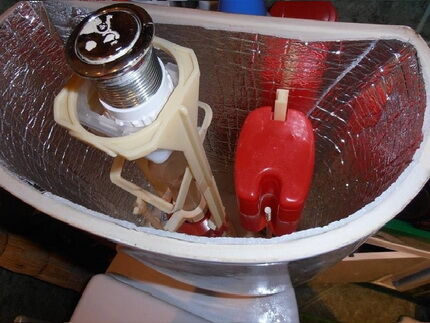
If a crack appears at the base of the toilet, it will not be visually noticeable. However, water from it will constantly leak to the neighbors below. They will be the first to notice the problem. In this case, no temporary measures will help. The toilet will have to be replaced immediately.
Water leakage due to excessive condensation
During the cold season, a puddle may appear on the floor without a leak. Unfortunately, many people do not know about this and waste time and energy searching for leaks. Everything is very simple. Very cold water enters the tank, causing condensation to form on it.Moisture accumulates, flows down and forms a puddle.
There are several ways to cope with an unpleasant phenomenon:
- Installation of a drain tank, inside of which a plastic water tank is built. Such equipment costs a little more than usual, but condensation never appears on it.
- Installation of a heat exchanger, passing through which the water will heat up slightly. The liquid entering the reservoir will no longer be so cold that condensation can form.
- Dehumidifying the air in the bathroom by installing an effective forced-type ventilation system.
- Arrangement of thermal insulation of the drain tank. To do this, the inside of the container is covered with waterproof heat-insulating material.
Another way to deal with condensation is to place a rag on the floor in the place where water usually accumulates. From time to time it will have to be squeezed out, and the design of the room will change not for the better. But it is quite effective and practically free. In addition, you will only have to use a rag in cold weather. During the warm season, condensation does not form on the tank. Read more about the causes of tank fogging and how to eliminate them. Further.
Leak on the cuff under the toilet shelf
Such problems usually arise in toilets of older models, where the tank and shelf were connected by a special rubber cuff. Over time, rubber dries out and cracks. Water begins to leak into the cracks that appear.
To solve the problem it is necessary replace a worn cuff. This is quite easy to do. First you need to purchase a new part. In this case, it is advisable to choose the most elastic product.
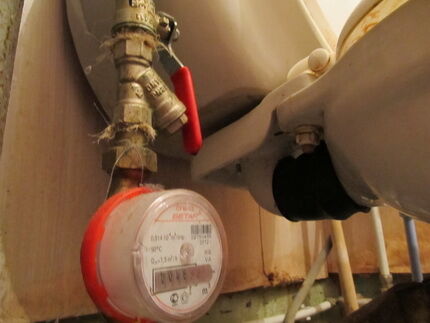
Now you can get to work. If the water supply has not yet been shut off, you need to do so. Then you should completely empty the tank. After this, you need to find the bolts that secure the shelf to the toilet. They need to be unscrewed. The next step is to remove the cuff. To do this, you need to pull the tank a little to the side to make it more convenient to work. There is no need to disconnect the flexible connection.
The cuff is pulled from its seat at the shelf outlet, and a new part is installed in its place. It needs to be rolled up, after which you can install the tank. It must be secured in place with mounting bolts.The new cuff is then unrolled slightly and pulled over the toilet outlet.
If during trial use a leak is noticed in the new cuff, it is tightened with wire. This should be done from the side opposite to where moisture appears.
Damage to the drain mechanism and seal
If a leak occurs at the junction of the drain hole from the tank to the toilet, it means that the O-ring has worn out or the drain mechanism has broken. In order to correct the situation, the following actions are performed:
Leak at the junction of the flush tank and the shelf
Compact model toilets are very practical. Their distinctive feature is a bowl, cast together with a shelf under the tank. The latter is installed on it and secured with bolts. If they are not tightened correctly or the gasket fails, the connection will leak.
Bolts that are not tightened completely or at an angle can be considered incorrectly tightened. To solve this problem, you just need to tighten them correctly.
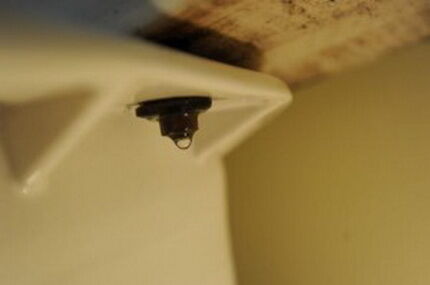
But simply tightening the fasteners most often will not help; moreover, it can only aggravate the problem by increasing the inclination of the bolts. In the worst case, the drain tank will simply crack. You need to do the following.
First, turn off the water supply and drain all the liquid from the tank. Then you should loosen the bolts so that the nuts can be unscrewed by hand. Then align the fasteners evenly and tighten them carefully. First by hand, then with a wrench or pliers.
This is the simplest repair option. It also happens that the gaskets have lost their elasticity or the metal washers on the mounting screws have rotted. In any case, the tank will need to be dismantled and worn parts replaced.
The procedure is quite simple. First, the water supply is turned off, the flexible line is disconnected and the tank is disassembled. The cover is removed, depending on the model, this is done in different ways.
The most difficult thing is with push-button type products. Next, the “insides” of the tank are carefully disassembled and removed. Having reached the gaskets and fasteners, you must remove them as carefully as possible so as not to damage the equipment body.
Craftsmen recommend that in completely hopeless cases, when the nuts are strongly stuck to the screws, use a grinder with a hacksaw blade or a thin cutting wheel to saw through the fasteners.
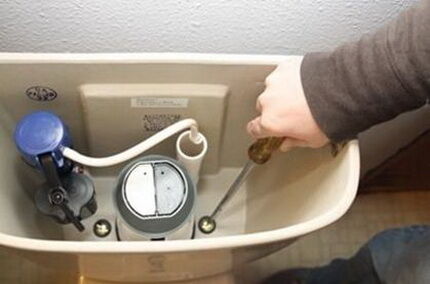
After this you need to put a new gasket on drain mechanism. It is placed in the tank and tightened with a plastic nut on the reverse side. Next, replace the washers and rubber gaskets for the mounting screws.A rubber sealing ring is placed on each of the bolts. After which they are screwed into place.
The internal parts are installed one by one in the tank, then the flexible line is connected and finally the lid is mounted.
Factory defective toilet
Sometimes the question arises: why does water flow in a new toilet? Unfortunately, in pursuit of maximum savings or due to an unfavorable combination of circumstances, you can buy a toilet with a factory defect. Of course, in a store, a buyer carefully examines a plumbing fixture and is unlikely to buy a fixture with a crack in the bowl or base. But the defect may also be hidden.
For example, in the depths of the body in the area of the siphon there may be an inconspicuous crack or an area not filled with enamel. In such cases, a leak will appear immediately after installing the toilet or a short time after you start using it. It will be almost impossible to eliminate it. Just replacing the toilet.
Therefore, it is important to purchase products from well-established manufacturers and carefully inspect the device before purchasing.
Conclusions and useful video on the topic
How to permanently get rid of condensation on a toilet cistern:
What to do when there is a leak in the toilet:
What to do if there is a leak in the drain tank:
A leak in the toilet can occur for a variety of reasons. And in each individual case you will have to look for it yourself. Possibly searching causes of leakage and its repair will be beyond the capabilities of a novice plumber. Then you should seek help from specialists.
However, if you wish, you can deal with almost any leak on your own. It is important to follow all instructions correctly and act carefully and carefully.
Do you have any questions about the topic of this article? Have you found any bugs or have valuable information that you can share with our site visitors? Please leave your comments, share tips, and ask questions in the block below.




Recently the toilet broke down and the plumber refused to come until after the holidays. So my husband had to fix it himself. To do this, he consulted with salespeople at a plumbing store about the features of the toilet and watched a lot of videos on the Internet. Worked for a few days and eventually fixed it myself. If I had found your advice earlier, it would have been easier.
A few months ago I began to notice water near the toilet, and I immediately realized that it was necessary to fix the breakdown as quickly as possible. After a thorough inspection, I found out that the corrugation had failed and a small crack had appeared. I read information on the Internet, watched a lot of videos and websites. I bought a new corrugation. The replacement took almost a whole day, but the damage was fixed.
I noticed that after flushing, water continues to accumulate in the tank and constantly flows from the drain pipe. The rubber bulb and the drain valve seal have failed. It's all about long-term use, the rubber gets rougher and becomes inelastic. Repairing rubber parts is not so easy, and you can waste time. So I bought a new bulb and seal at the store. Fortunately, installation does not require any special knowledge or skills.
We installed a new toilet, and almost immediately after flushing, a trickle of water began to creep out from under the “leg” of the toilet... The plumber who installed it refuses to come, does this mean the end of the toilet?